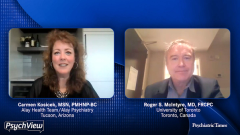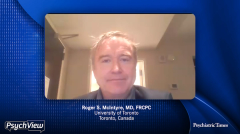
New Treatment Options in MDD
Roger S. McIntyre, MD, FRCPC; and Carmen Kosicek, MSN, PMHNP-BC; review the mechanism of action of newer therapies in MDD treatment.
Episodes in this series

Roger S. McIntyre, MD, FRCPC: Absolutely. And the bupropion-dextromethorphan combination…has been FDA-approved as a rapid-acting oral antidepressant in nontreatment-resistant populations and in the treatment-resistant depressed population, which the FDA defines as people who’ve had depression and just not had an adequate improvement with at least 3 antidepressants. That group…unfortunately is quite common. We have other treatments approved like esketamine, and we have off-label treatments like ketamine that have shown benefit in rapid alleviation of symptoms as meaningful. Let’s just tilt the conversation a bit, Carmen. We’re talking about some new treatment options, some hopeful treatment options that are rapidly alleviating. And as you mentioned, we’ve got some new GABAergic agents. Let’s talk a little bit about the mechanism of action. Our colleagues who are joining us today are probably scratching their heads saying, “Hang on, don’t all roads lead to serotonin? Are we not still worshiping at the altar of serotonin? Aren’t these all these new drugs? Are they serotonin reuptake inhibitors? How do they work faster?” What would you say?
Carmen Kosicek, MSN, PMHNP-BC:I would say that there’s actually a lot of questionable data in the literature. Showcasing the true efficacy of SSRIs [selective serotonin reuptake inhibitors] is that [that] technology is more than 30 to 40 years old. I cannot imagine if I kept up with technology from 30 to 40 years ago, I wouldn’t even have a bag phone, let alone the phones with the big, long antennas on them. So if you’re going to update your phones, you need to make sure that you’re updating medications to not only help your patients, but to help the greater good of mankind, of all these people who are around us. So learning about the different mechanisms of action is key. And again, it gets back to the same thing. If you continue to do the same thing that you’ve always done and you’re not getting the outcome that you’re seeking, it really is time to open your mind to try something new. I hear all the time, “I don’t want to try anything new. Like we have to wait for a while for that.” Sure, [but] it’s OK. Well, the FDA is the one who termed it OK. After these clinical trials not only went through the rigorous process of phase 1, phase 2, phase 3 and so on, but [also] there’s 1 year of data on it. I mean, for goodness sake, what are you waiting for? It is then up to the FDA and the pharmaceutical company if there are challenges. But as a provider, your patients are begging and seeking quick treatment. It is my role and my job to explain what’s out there. And to give a risk benefit ratio for the patient along with addressing fiscal attainability. Then let’s help these patients to feel better. It truly is an educated decision.
Roger S. McIntyre, MD, FRCPC: It sure is. It’s so interesting. The other part about psychiatry and pharmacology for depression that is really so hopeful is that we have neuroscience. We have really interesting neuroscience that’s shedding new light on what we think is happening in the brain in depression and what we think the drugs are actually doing. I think we have to be humble because we don’t yet know with certainty how antidepressants alleviate symptoms. So that certainly remains far from clear. But what we do know based on science is that conventional antidepressants like SSRIs have an effect on what’s called neurotropism and neuroplasticity. All that really means [is that] they grow the brain cells and…help them connect together, those neurons that fire together, wired together. So we want our brain cells to grow, we want our brain cells to connect. Interestingly, in depression, the prevailing view at the cellular level is there’s something wrong with the viability of our brain cells and how they’re connecting. So this is, if you will, the reversal of that. Well, if that’s the case, why do we just leave SSRI alone? Sounds like they’re the perfect treatment. Well, they’re not the perfect treatment because they take too long to work [for] many people [and they] don’t work for everybody. So there’s other ways to think about this. The way I think about this calmness is going to the airport nowadays with everyone returning back to flying again. You go to the lineup at the airport. If you don’t have TSA [Transportation Security Administration] [Clear precheck], you’re waiting for a long time. And I see the SSRI as the regular lineup in the TSA and the Clear line that [are] some of these other new mechanisms. So they’re kind of landing on the same area. They get into the same gate, they’re going to improve trophies, they increased brain cell viability and increased plasticity connections. They just do it faster. And when you give a treatment that targets, for example, the glutamate system or the GABA system, which are the 2 systems we’re putting in the crosshairs here today, what’s interesting is that they result in an improved trophic or brain cell growth and plasticity effect at the molecular and cellular level. But rather than waiting 4 to 6 weeks, it’s doing it right away, after, in some cases, a single exposure—in other words, it happens very quickly. What’s interesting is that we don’t treat mice, we don’t treat rats. But that’s what we do [with] a lot of our research. And in these animal models, the benefit in the animal is seen instantly. It’s seen right away. And that maps to what the scientists are seeing with the molecular and cellular studies. So there’s a working hypothesis that when you have a glutamate—which is the esketamine-, ketamine-, dextromethorphan-type targets, or you’re looking at zuranolone, recently approved for postpartum depression—when you look at these drugs, what they’re doing is they are resulting in changes to the molecules and cells in our brain that are affecting them in a way that we think is therapeutic but doing it right away. It’s like the Clear line, the TSA line at the airport. It’s sort of a silly metaphor, but it’s kind of [how] I see it, and it’s really interesting how that maps on to what people see clinically.
Transcript is AI-generated and edited for clarity and readability.
Newsletter
Receive trusted psychiatric news, expert analysis, and clinical insights — subscribe today to support your practice and your patients.
















